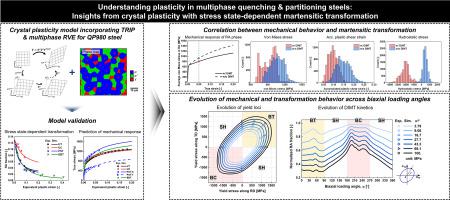当前位置:
X-MOL 学术
›
Int. J. Plasticity
›
论文详情
Our official English website, www.x-mol.net, welcomes your feedback! (Note: you will need to create a separate account there.)
Understanding plasticity in multiphase quenching & partitioning steels: Insights from crystal plasticity with stress state-dependent martensitic transformation
International Journal of Plasticity ( IF 9.4 ) Pub Date : 2024-07-17 , DOI: 10.1016/j.ijplas.2024.104075 Jinheung Park , Yong Hou , Junying Min , Zeran Hou , Heung Nam Han , Binbin He , Myoung-Gyu Lee
International Journal of Plasticity ( IF 9.4 ) Pub Date : 2024-07-17 , DOI: 10.1016/j.ijplas.2024.104075 Jinheung Park , Yong Hou , Junying Min , Zeran Hou , Heung Nam Han , Binbin He , Myoung-Gyu Lee

|
This study develops a novel crystal plasticity (CP) model incorporating deformation-induced martensitic transformation (DIMT) and transformation-induced plasticity (TRIP) effect to predict the complex interplay between microstructural evolution and mechanical behavior in a third-generation advanced high-strength steel QP980. This model introduces phenomenological theory of martensite crystallography (PTMC) based TRIP theory and DIMT kinetics grounded on nucleation-controlled phenomenon. Notably, the DIMT model is improved by utilizing a geometric approach for calculating shear band intersections. A virtual multiphase representative volume element (RVE) based on the Voronoi tessellation is generated for the QP980 steel, which comprises ferrite, martensite, and retained austenite (RA). The study highlights how phase transformation affects mechanical properties, notably the strengthening from transformed martensite and the mechanical alterations in RA due to the TRIP effect. The DIMT kinetics dependent on stress states such as uniaxial tension (UT), uniaxial compression (UC), plane strain tension (PST), and equi-biaxial tension (EBT) are analyzed using the developed model. The role of microstructural surroundings on martensitic transformation is also examined. Furthermore, analysis under biaxial loading angles using the model reveals an asymmetric yield surface, with more pronounced changes in yield stress in the tensile region due to accelerated transformation behaviors, as opposed to the more gradual transformations in the compressive region. This study provides valuable insights into the deformation mechanisms of the third-generation advanced high-strength steels including relationship between plastic anisotropy, transformation kinetics, and microstructural evolution.
中文翻译:

了解多相淬火和分配钢的塑性:从晶体塑性与应力状态相关的马氏体转变的见解
本研究开发了一种新颖的晶体塑性(CP)模型,结合了变形诱发马氏体相变(DIMT)和相变诱发塑性(TRIP)效应,以预测第三代先进高强度钢的微观结构演变和机械行为之间的复杂相互作用。 QP980。该模型引入了基于 TRIP 理论的马氏体晶体学 (PTMC) 现象学理论和基于成核控制现象的 DIMT 动力学。值得注意的是,通过利用几何方法计算剪切带交叉点,DIMT 模型得到了改进。为 QP980 钢生成基于 Voronoi 曲面细分的虚拟多相代表体积单元 (RVE),其中包括铁素体、马氏体和残余奥氏体 (RA)。该研究强调了相变如何影响机械性能,特别是相变马氏体的强化以及 TRIP 效应导致的 RA 机械变化。使用开发的模型分析了依赖于单轴拉伸 (UT)、单轴压缩 (UC)、平面应变拉伸 (PST) 和等双轴拉伸 (EBT) 等应力状态的 DIMT 动力学。还研究了微观结构环境对马氏体转变的作用。此外,使用该模型在双轴加载角下进行的分析揭示了不对称的屈服面,由于加速转变行为,拉伸区域的屈服应力变化更加明显,而压缩区域的屈服应力变化则更为平缓。这项研究为第三代先进高强度钢的变形机制提供了有价值的见解,包括塑性各向异性、转变动力学和微观结构演化之间的关系。
更新日期:2024-07-17
中文翻译:

了解多相淬火和分配钢的塑性:从晶体塑性与应力状态相关的马氏体转变的见解
本研究开发了一种新颖的晶体塑性(CP)模型,结合了变形诱发马氏体相变(DIMT)和相变诱发塑性(TRIP)效应,以预测第三代先进高强度钢的微观结构演变和机械行为之间的复杂相互作用。 QP980。该模型引入了基于 TRIP 理论的马氏体晶体学 (PTMC) 现象学理论和基于成核控制现象的 DIMT 动力学。值得注意的是,通过利用几何方法计算剪切带交叉点,DIMT 模型得到了改进。为 QP980 钢生成基于 Voronoi 曲面细分的虚拟多相代表体积单元 (RVE),其中包括铁素体、马氏体和残余奥氏体 (RA)。该研究强调了相变如何影响机械性能,特别是相变马氏体的强化以及 TRIP 效应导致的 RA 机械变化。使用开发的模型分析了依赖于单轴拉伸 (UT)、单轴压缩 (UC)、平面应变拉伸 (PST) 和等双轴拉伸 (EBT) 等应力状态的 DIMT 动力学。还研究了微观结构环境对马氏体转变的作用。此外,使用该模型在双轴加载角下进行的分析揭示了不对称的屈服面,由于加速转变行为,拉伸区域的屈服应力变化更加明显,而压缩区域的屈服应力变化则更为平缓。这项研究为第三代先进高强度钢的变形机制提供了有价值的见解,包括塑性各向异性、转变动力学和微观结构演化之间的关系。
















































 京公网安备 11010802027423号
京公网安备 11010802027423号